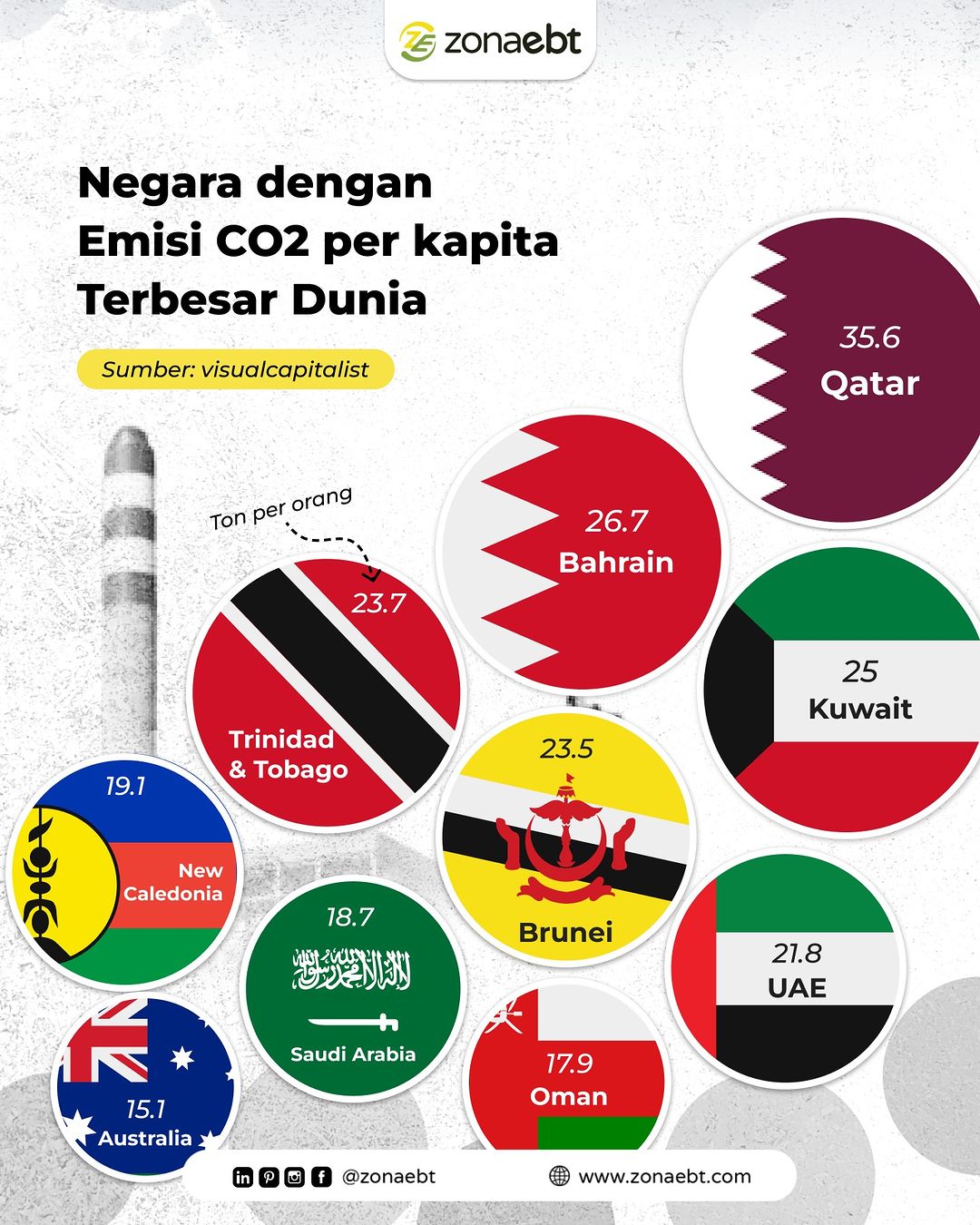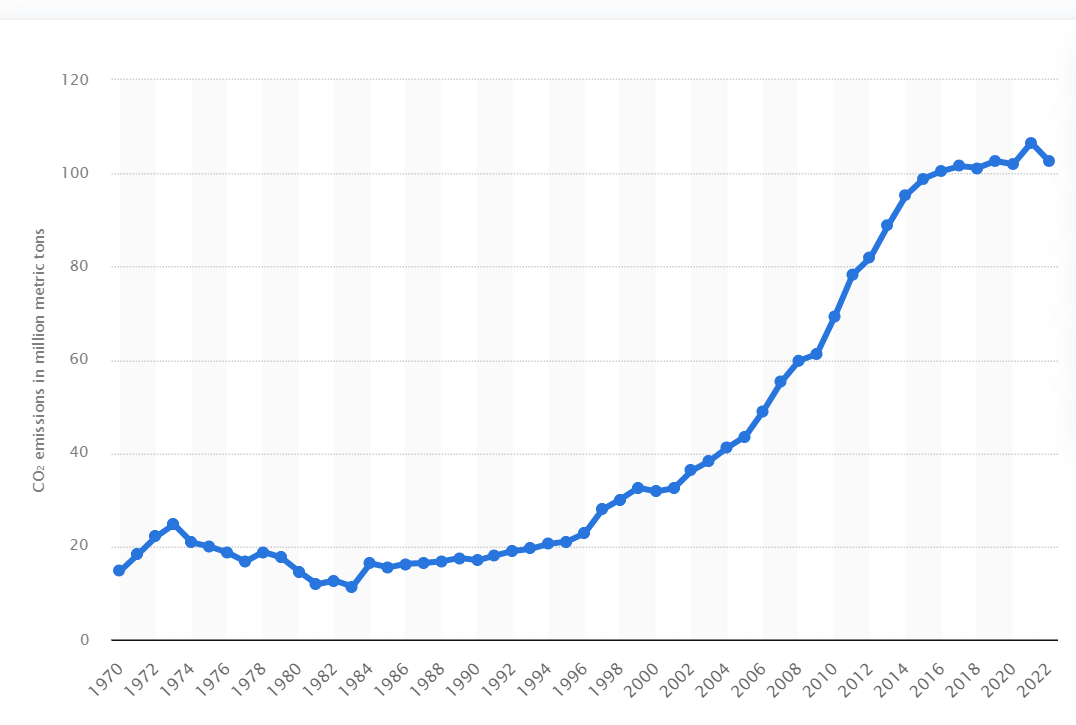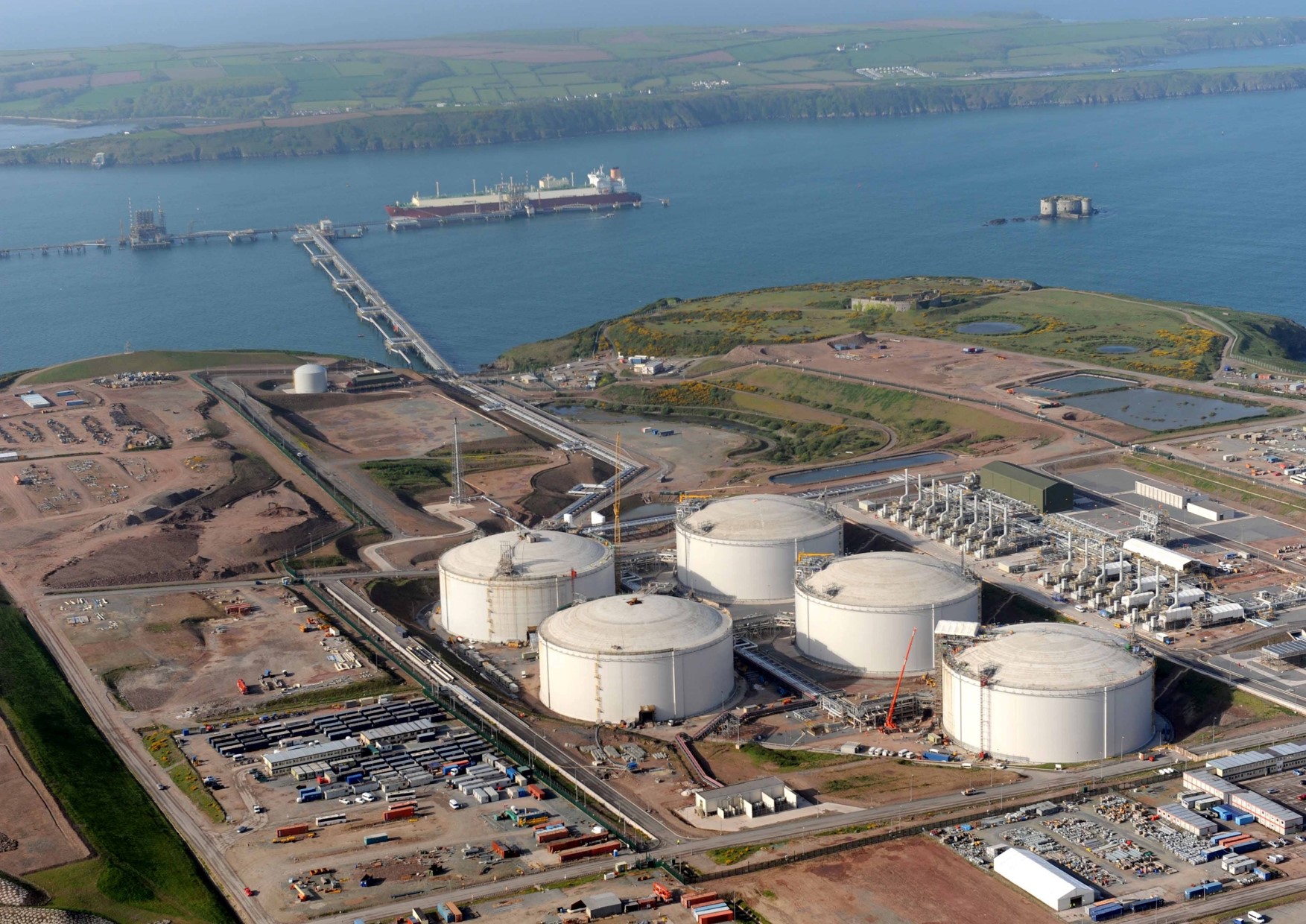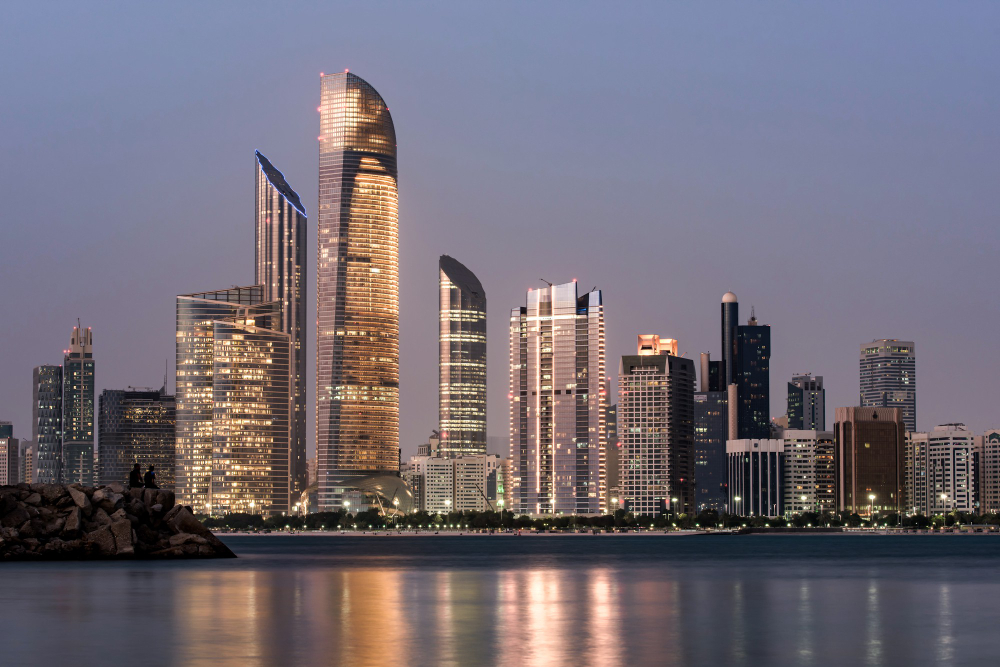
- Qatar emits the most CO2 emissions per capita worldwide, at more than 35 metric tons per person.
- Qatar announced its goal to reduce greenhouse gas emissions by 25 percent by 2030
- Qatar has 5C Carbon Management Framework
Fossil fuel combustion and industrial processes in Qatar produced 102.6 million metric tons of carbon dioxide (MtCO₂) emissions in 2022. This was a reduction of 3.7 percent in comparison to the previous year, when emissions peaked at nearly 107 MtCO₂.
Qatar emits the most CO2 emissions per capita worldwide, at more than 35 metric tons per person. Qatar CO2 emissions from fossil fuel and industrial purposes from 1970-2022 continue to increase each year like the picture below.

The State of Qatar has set a national target to reduce its greenhouse gas (GHG) emissions by 25 percent by 2030. This goal is one of the key objectives and top priorities of Qatar National Vision 2030, which focuses on sustainable social and environmental projects and technologies, economic and industrial diversification, and the development of a mix of energy sources.
Climate change is an increasing focus for the Qatari government. This is demonstrated by Qatar’s commitment to form the Ministry of Environment and Climate Change in October 2021 and renamed Qatar Petroleum as QatarEnergy (QE).
Baca Juga
- Potensi Global? Ini Total Penyimpanan Karbon Milik Indonesia
- Peran Pengukuran Karbon dalam Keberlanjutan Lingkungan
Reduce Carbon Emissions 25 Percent by 2030

QE, as the country’s national oil company, is working with the Ministry of Environment and Climate Change to implement Qatar’s National Environment and Climate Strategy. QE is incorporating liquefied natural gas (LNG) into its climate change and sustainability practices, noting that LNG is the cleanest of the fossil fuels (LNG produces 40% less carbon dioxide than coal and 30% less than oil) and is the preferred fuel for transitioning from coal and oil to more sustainable energy sources.
In August 2021, QE announced its goal to reduce greenhouse gas emissions by 25% by 2030 and committed $170 million to this effort, which focuses on reducing flaring and methane emissions. QE has also developed a comprehensive sustainability plan to improve green, energy-efficient practices at existing LNG facilities and those under development as part of the North Field LNG Expansion Project.

Based on the QE sustainability report 2022, Qatar has made progress in reducing carbon emissions. These advancements include secure and affordable supply of cleaner natural gas for rapid reduction in carbon intensity of the power grid, carbon capture and storage (ccs) value chain at scale, new low-energy options, and development of solar generation.
In addressing the carbon problem resulting in climate change, Qatar has climate change mitigation and adaptation measures. Let’s see the following information.
Qatar Mitigation Measures

QE is committed to playing a leading role in reducing greenhouse gas emissions and transitioning to a low-carbon economy through a range of climate change mitigation measures. Qatar’s efforts to reduce emissions begin at the macro level, where they’re working to reduce GHG emissions by providing energy users with natural gas, the cleanest hydrocarbon and one of the most reliable, affordable, and sustainable energy sources.
Qatar is also committed to reducing their own emissions from operations. Qatar has implemented energy efficiency measures at many facilities and processes, and regularly monitors emissions and has set targets to further reduce their carbon footprint. Qatar is also exploring CCS technologies and actively exploring ways to circulate and reuse emissions.
Qatar Adaptation Measures

Qatar’s approach to climate change adaptation involves a range of strategies, including enhancing infrastructure resilience, transitioning to renewable energy sources, and promoting sustainable land use practices. Specialized in carbon issues, Qatar has 5C Carbon Management Framework (consolidate, curb, create, compensate and circulate).
- Consolidate, supplying low-carbon energy to replace high carbon intensity fuels
- Curb, reducing operational emissions
- Create, generating low-carbon energy
- Compensate, Storing and offsetting residual and hard-to abate emissions
- Circulate, (reducing, recycling and repurposing waste)
Baca Juga
- EU ETS: The Biggest Carbon Market in The World
- The United States: a Giant of Carbon Capture and Storage
So that’s the information about carbon in Qatar. We’ll be back again with carbon information from other parts of the world, stay tuned Sobat EBT Heroes.
#zonaebt #EBTHeroes #Sebarterbarukan
Editor: Alvin Pratama
References
[1] Qatar: Fossil CO2 Emissions 1970-2022
[2] Qatar Energy Greenhouse Gas (Ghg) Emissions Reductions And Sustainability Initiatives





74 Comment
pin up casino https://azerbaijancuisine.com/# pin-up cazino
pin-up 306
mexican pharmaceuticals online mexican northern doctors mexico drug stores pharmacies
buying prescription drugs in mexico online northern doctors pharmacy mexican online pharmacies prescription drugs
There are so many online casinos these days, do you need my help on how to join? just visit here it will help you.
https://main7.top/thenine/
mexican drugstore online northern doctors pharmacy medication from mexico pharmacy
pharmacies in mexico that ship to usa: mexican pharmacy – medication from mexico pharmacy
mexico pharmacy: buying prescription drugs in mexico – buying prescription drugs in mexico online
mexican mail order pharmacies: Mexico pharmacy that ship to usa – mexico drug stores pharmacies
https://northern-doctors.org/# mexican mail order pharmacies
purple pharmacy mexico price list northern doctors mexican mail order pharmacies
mexico drug stores pharmacies: mexican northern doctors – purple pharmacy mexico price list
https://northern-doctors.org/# mexican border pharmacies shipping to usa
best online pharmacies in mexico: northern doctors – mexico pharmacies prescription drugs
reputable mexican pharmacies online: northern doctors – buying prescription drugs in mexico online
https://northern-doctors.org/# medication from mexico pharmacy
medication from mexico pharmacy: Mexico pharmacy that ship to usa – buying from online mexican pharmacy
п»їbest mexican online pharmacies: mexican northern doctors – best online pharmacies in mexico
http://northern-doctors.org/# mexican pharmacy
mexican border pharmacies shipping to usa northern doctors mexico pharmacies prescription drugs
medication from mexico pharmacy: Mexico pharmacy that ship to usa – mexican pharmaceuticals online
http://northern-doctors.org/# buying prescription drugs in mexico
mexican online pharmacies prescription drugs: mexican northern doctors – purple pharmacy mexico price list
medication from mexico pharmacy: northern doctors pharmacy – mexico drug stores pharmacies
http://northern-doctors.org/# mexico drug stores pharmacies
mexico pharmacy: mexican pharmacy – mexican pharmaceuticals online
http://northern-doctors.org/# mexican border pharmacies shipping to usa
medication from mexico pharmacy: mexican northern doctors – medicine in mexico pharmacies
mexico pharmacies prescription drugs: mexican pharmacy online – reputable mexican pharmacies online
mexican online pharmacies prescription drugs northern doctors pharmacy mexican rx online
http://northern-doctors.org/# mexico pharmacy
buying from online mexican pharmacy: mexican pharmacy – mexican mail order pharmacies
buying prescription drugs in mexico online: mexican pharmacy northern doctors – pharmacies in mexico that ship to usa
https://northern-doctors.org/# mexico drug stores pharmacies
https://cmqpharma.online/# medicine in mexico pharmacies
medication from mexico pharmacy
mexican rx online mexican online pharmacy buying prescription drugs in mexico online
mexico drug stores pharmacies: cmqpharma.com – buying from online mexican pharmacy
buying from online mexican pharmacy cmq pharma mexican pharmacy mexico drug stores pharmacies
mexico pharmacies prescription drugs online mexican pharmacy mexican drugstore online
medication from mexico pharmacy cmq mexican pharmacy online mexican mail order pharmacies
mexico drug stores pharmacies mexican online pharmacy mexican online pharmacies prescription drugs
mexican mail order pharmacies
https://cmqpharma.com/# purple pharmacy mexico price list
buying prescription drugs in mexico
medicine in mexico pharmacies purple pharmacy mexico price list pharmacies in mexico that ship to usa
п»їbest mexican online pharmacies cmq mexican pharmacy online mexico pharmacies prescription drugs
mexico drug stores pharmacies mexico pharmacy buying from online mexican pharmacy
mexican online pharmacies prescription drugs mexican rx online buying prescription drugs in mexico online
http://cmqpharma.com/# buying prescription drugs in mexico online
reputable mexican pharmacies online
medication from mexico pharmacy mexican online pharmacy mexico drug stores pharmacies
canadian online pharmacy reviews: canada pharmacy reviews – canada rx pharmacy
reputable canadian online pharmacy: best canadian pharmacy to order from – canadian pharmacies online
indian pharmacy buy prescription drugs from india Online medicine home delivery
canadianpharmacymeds com: recommended canadian pharmacies – cheapest pharmacy canada
mexican mail order pharmacies buying from online mexican pharmacy mexican border pharmacies shipping to usa
mexican rx online: medicine in mexico pharmacies – mexican drugstore online
india online pharmacy: india online pharmacy – best online pharmacy india
canadian pharmacy sarasota: canada pharmacy world – online canadian pharmacy reviews
buy prescription drugs from india: pharmacy website india – buy prescription drugs from india
mexico pharmacy reputable mexican pharmacies online buying prescription drugs in mexico online
п»їbest mexican online pharmacies: mexican rx online – mexican online pharmacies prescription drugs
mexico pharmacy: mexico pharmacies prescription drugs – reputable mexican pharmacies online
mexico drug stores pharmacies: mexican online pharmacies prescription drugs – mexican rx online
online shopping pharmacy india india online pharmacy india pharmacy mail order
mexican mail order pharmacies: mexican online pharmacies prescription drugs – buying prescription drugs in mexico
mexican rx online: п»їbest mexican online pharmacies – buying prescription drugs in mexico online
mexican pharmacy: п»їbest mexican online pharmacies – purple pharmacy mexico price list
http://clomiddelivery.pro/# can i get cheap clomid without rx
http://doxycyclinedelivery.pro/# doxycycline tablets cost
https://clomiddelivery.pro/# can you buy clomid
http://doxycyclinedelivery.pro/# doxycycline 40 mg generic coupon
https://paxloviddelivery.pro/# paxlovid pill
https://clomiddelivery.pro/# can i get cheap clomid without prescription
http://paxloviddelivery.pro/# paxlovid india
http://clomiddelivery.pro/# how can i get cheap clomid without a prescription
https://paxloviddelivery.pro/# Paxlovid over the counter